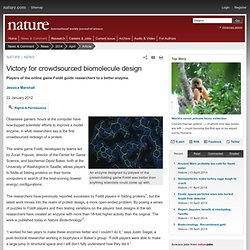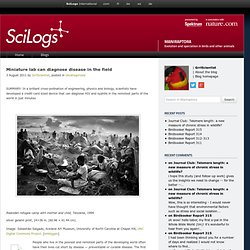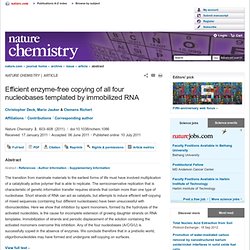

Victory for crowdsourced biomolecule design. An enzyme designed by players of the protein-folding game Foldit was better than anything scientists could come up with.

Obsessive gamers’ hours at the computer have now topped scientists’ efforts to improve a model enzyme, in what researchers say is the first crowdsourced redesign of a protein. The online game Foldit, developed by teams led by Zoran Popovic, director of the Center for Game Science, and biochemist David Baker, both at the University of Washington in Seattle, allows players to fiddle at folding proteins on their home computers in search of the best-scoring (lowest-energy) configurations. The researchers have previously reported successes by Foldit players in folding proteins1, but the latest work moves into the realm of protein design, a more open-ended problem.
By posing a series of puzzles to Foldit players and then testing variations on the players’ best designs in the lab, researchers have created an enzyme with more than 18-fold higher activity than the original. Cancer drugs affect mouse genomes for generations. Three common chemotherapy drugs cause DNA mutations not only in mice that receive treatment, but also in their offspring, according to a study published today in the Proceedings of the National Academy of Sciences USA1.

The results suggest that the genome in treated mice became destabilized yielding new mutations long after exposure to the drugs has ceased. A similar phenomenon has been observed in mice exposed to radiation. Genomic damage can be seen in the offspring of mice who have received chemotherapy drugs. The work emphasizes the importance of looking at the effects of chemotherapy not only on recipients, but also on their descendants. But Yuri Dubrova, a geneticist at the University of Leicester, UK, who led the study, cautions against extrapolating the results of this study to humans. Home : Scientific Reports.
Darwinian evolution of an alternative genetic system provides support for TNA as an RNA progenitor : Nature Chemistry. The pre-RNA world hypothesis postulates that RNA was preceded in the evolution of life by a simpler genetic material, but it is not known if such systems can fold into structures capable of eliciting a desired function.

Presumably, whatever chemistry gave rise to RNA would have produced other RNA analogues, some of which may have preceded or competed directly with RNA. Threose nucleic acid (TNA), a potentially natural derivative of RNA, has received considerable interest as a possible RNA progenitor due to its chemical simplicity and ability to exchange genetic information with itself and RNA. Here, we have applied Darwinian evolution methods to evolve, in vitro, a TNA receptor that binds to an arbitrary target with high affinity and specificity. Non-coding RNAs in human disease : Abstract : Nature Reviews Genetics. Inhibition of miR-33a/b in non-human primates raises plasma HDL and lowers VLDL triglycerides : Nature. 1deGoma, E.

M. & Rader, D. J. Novel HDL-directed pharmacotherapeutic strategies. Nature Rev. Cardiol. 8, 266–277 (2011)CAS Article Google Scholar 2Moore, K. Lunchtime science : Nature. Molecular Systems Biology. Abstract The number of sequenced species is increasing at a staggering rate, calling for new approaches for incorporating evolutionary information in the study of biological mechanisms.

Evolutionary conservation is widely used for assigning a function to new proteins and for predicting functional coding or non‐coding sequences. Here, we argue for a complementary approach that focuses on the divergence of regulatory programs. Regulatory mechanisms can be learned from patterns of evolutionary divergence in regulatory properties such as gene expression, transcription factor binding or nucleosome positioning.
We review examples of this concept using yeast as a model system, and highlight a hybrid‐based approach that is highly instrumental in this analysis. The basic approach: why comparing related species could help in identifying regulatory mechanisms The ability to rapidly and cheaply sequence full genomes is revolutionizing biological research. Figure 1. Genes diverge at different rates. LincRNAs act in the circuitry controlling pluripotency and differentiation : Nature : Nature Publishing Group. Although thousands of large intergenic non-coding RNAs (lincRNAs) have been identified in mammals, few have been functionally characterized, leading to debate about their biological role.

To address this, we performed loss-of-function studies on most lincRNAs expressed in mouse embryonic stem (ES) cells and characterized the effects on gene expression. Here we show that knockdown of lincRNAs has major consequences on gene expression patterns, comparable to knockdown of well-known ES cell regulators. Notably, lincRNAs primarily affect gene expression in trans. Knockdown of dozens of lincRNAs causes either exit from the pluripotent state or upregulation of lineage commitment programs. We integrate lincRNAs into the molecular circuitry of ES cells and show that lincRNA genes are regulated by key transcription factors and that lincRNA transcripts bind to multiple chromatin regulatory proteins to affect shared gene expression programs.
Figures Read the full article. Miniature lab can diagnose disease in the field - Maniraptora: Tastes Like Chicken Blog. SUMMARY: In a brilliant cross-pollination of engineering, physics and biology, scientists have developed a credit-card sized device that can diagnose HIV and syphilis in the remotest parts of the world in just minutes Rwandan refugee camp with mother and child, Tanzania, 1994 silver gelatin print, 24×36 in. (60.96 × 91.44 cm).

Image: Sebastião Salgado, Ackland Art Museum, University of North Carolina at Chapel Hill, UNC Digital Commons Project. [embiggen] Efficient enzyme-free copying of all four nucleobases templated by immobilized RNA : Nature Chemistry. The transition from inanimate materials to the earliest forms of life must have involved multiplication of a catalytically active polymer that is able to replicate.

Evidence of altered RNA stirs debate.